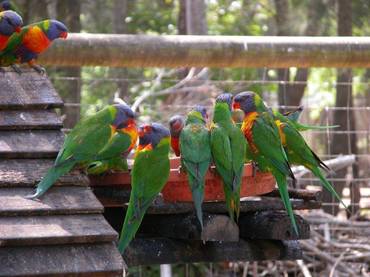Don't feed the birds
|
Hand-fed birds can become a nuisance - encouraging large numbers of birds. This can be a problem, especially with aggresive bird species. Sulphur crested cockatoos which have been hand fed have been known to demolish cedar window frames, doors and even TV arials when the occupants stop feeding them.
Hand-fed birds are susceptible to illnesses that can be transferred to other birds and it is possible that some birds become so dependent on feding stations that they may starve if and when the people are away. there is also evidence to suggest that hand feeding can also affect bird breeding cycles. There is also evidence that hand feeding might impact on local bird populations, encouraging an influx of birds such as rainbow lorikeets, corellas and rosellas, while displacing less aggresive birds and mammals. |
A danger to lorikeets
The tip of a lorikeet's tongue holds a brush-like appendage, enabling it to feed on pollen, nectar and fruit. Their natural diet also includes insects and other invertebrates. Some people encourage lorikeets by offering a variety of foods, many of which contain sugar, bread, honey or jam. It is thought that a diet rich in birdseed may also damage their tongue, making it harder to access pollen and nectar. This diet of unnatural foods can cause illness and even death in lorikeets. Lorikeets are susceptible to necrotizing enteritis - a disease associated with poor hygiene and inadequate diet, which may result from inadequate artificial diets and the unsanitary conditions around crowded feeding stations.
The tip of a lorikeet's tongue holds a brush-like appendage, enabling it to feed on pollen, nectar and fruit. Their natural diet also includes insects and other invertebrates. Some people encourage lorikeets by offering a variety of foods, many of which contain sugar, bread, honey or jam. It is thought that a diet rich in birdseed may also damage their tongue, making it harder to access pollen and nectar. This diet of unnatural foods can cause illness and even death in lorikeets. Lorikeets are susceptible to necrotizing enteritis - a disease associated with poor hygiene and inadequate diet, which may result from inadequate artificial diets and the unsanitary conditions around crowded feeding stations.
|
Another disease which has a serious impact on lorikeets is psittacine beak and feather disease (PBFD). It is a viral disease affecting parrots and other bird species globally. In the south east of NSW PBFD is a problem for the endangered Gang Gang and Yellow-tailed black cockatoos. The keratin in their bodies breaks down, causing deformed beaks and feathers and feather loss. While the disease is often fatal, infected birds may not display symptoms and continue spreading the virus. There is a great potential for the virus to spread at places like feed stations. Clustering in large numbers, many birds may come into contact with contaminated perches and food dishes.
Avoiding lorikeet deaths
The only feeding method recommended is to plant a variety of flowering native shrubs, such as grevilleas, callistemon (bottlebrushes) and banksias, to provide safe, healthy food for nectar feeding birds such as lorikeets and honeyeaters. Include some prickly shrubs for smaller birds such as finches and wrens to hide in. If you like to see birds up close, install a bird bath or water feature: An added benefit is this may also attract frogs to your garden. Sourced from: © State of New South Wales through the Office of Environment and Heritage |






